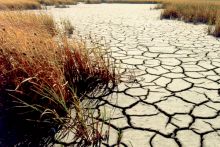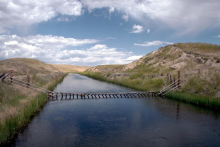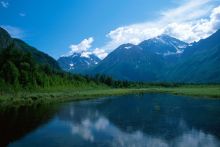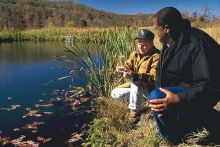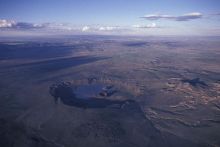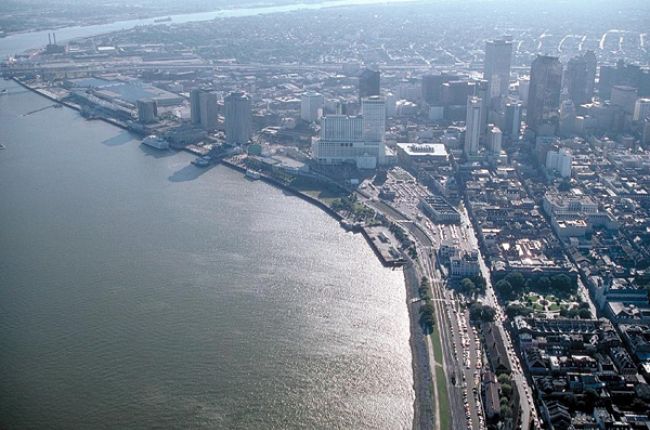
Material adapted from: Vandas, S.J., Winter, T.C., and Battaglin, W.A. 2002. Water and the Environment, p. 38-39. Published by the American Geosciences Institute Environmental Awareness Series. Click here to download the full handbook.
Land uses that impact water resources include agriculture, forestry, urbanization, recreation, and industrialization. Agriculture, the clearing of forests, and the draining of wetlands have caused significant modifications to the surface of the Earth. Tillage of the land and clear cutting of forests change infiltration and runoff characteristics, which affect groundwater recharge, sediment and water yield, and evapotranspiration.
Irrigation of lands changes the use and distribution of water. The removal of surface water and groundwater for irrigation changes the water’s natural distribution and impacts the ecosystems that depend upon it. Demand for water to irrigate crops usually occurs when there is insufficient precipitation during the growing season, potentially causing stream and groundwater levels to be reduced. In addition, irrigation waters that return to either groundwater or surface waters can contain salts, pesticides, or have elevated levels of nutrients such as nitrate and phosphorous.
These contaminants in turn can cause harm to plant and animal life that depend on the returned water. Drainage of shallow subsurface water is common in areas with high water tables and extensive wetlands. Drainage of such areas is necessary to convert land to agriculture or urban development, but it can result in decreased recharge to groundwater and increased flooding in the developed area. If wetlands are drained, biological impacts may be substantial because wetlands are some of the most biologically productive ecosystems on Earth. Between 1780 and 1980, an estimated 60 million acres of wetlands in the Mississippi River Basin were drained.
The Everglades in south Florida are an excellent example of how land use changes, specifically changes in water flow, can impact wetlands. In 1948, Congress authorized the Central and Southern Florida Project for Flood Control and Other Purposes (C&SF Project). Through this act, levees were constructed to divert surface water to control flooding, and drainage ditches were dug to lower groundwater levels so agriculture and residential areas could be developed in marsh and swamp lands. Flood control efforts focused on directing interior waters through canals to coastal areas. The drainage ditches quickly lowered groundwater levels. Within a few decades these flood and drainage systems changes caused:
- Elimination of approximately 1,500,000 million acres of wetlands,
- Reduction in the number of species located in the Everglades; such as the Florida panther, snail kite, and the American crocodile,
- Depletion of the water supply needed by the human population, and the
- Increased likelihood of wildfires.
The growth of cities and their associated infrastructure have greatly changed the historic uses of water. The removal of water from streams and groundwater systems to supply cities, and the land use changes associated with the development of the city, have consequences on the natural environment. For example, infiltration of water is reduced as the result of construction of highways, streets, parking lots and buildings. A reduction of infiltration can also increase runoff and the likelihood of flooding.
Learn More
- Our Built and Natural Environments: A Technical Review of the Interactions Between Land Use, Transportation, and Environmental Quality (2nd Edition) (Report), Environmental Protection Agency
This 2013 report discusses trends in land use, development, and transportation. Also discusses the relationship between the built environment and environmental quality. Also presents land use and transportation strategies for minimizing environmental and health impacts of development.
- Effects of Climate Change and Land Use on Water Resources in the Upper Colorado River Basin (Factsheet), U.S. Geological Survey
2011 factsheet providing a regional focus on the ways in which changing climate and land use will affect the Upper Colorado River Basin in the future.
- Landsat and Water: Case Studies of the Uses and Benefits of Landsat Imagery in Water Resources (Report), U.S. Geological Survey
2014 report on the ways in which the Landsat program is used to manage water resources. Because the Landsat program is effectively designed to monitor changes in land cover and land use, this report demonstrates the intimate interplay between land use and water resources.
- Land and Water Use Program (Website), California Department of Water Resources
Information on land and water use in California, with access to data including agriculture/irrigation and public water supplies

